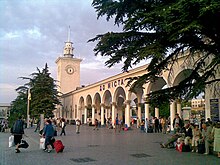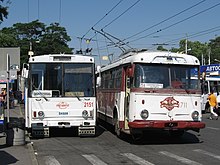Krymskyj trolejbus
| Krymskyj trolejbus | |||||||||||||||||||||||||||||||||||||||||||||||||||||||||||||||||||||||||||||||||||||||||||||||||||||||||||||||||||||||||||||||||||||
|---|---|---|---|---|---|---|---|---|---|---|---|---|---|---|---|---|---|---|---|---|---|---|---|---|---|---|---|---|---|---|---|---|---|---|---|---|---|---|---|---|---|---|---|---|---|---|---|---|---|---|---|---|---|---|---|---|---|---|---|---|---|---|---|---|---|---|---|---|---|---|---|---|---|---|---|---|---|---|---|---|---|---|---|---|---|---|---|---|---|---|---|---|---|---|---|---|---|---|---|---|---|---|---|---|---|---|---|---|---|---|---|---|---|---|---|---|---|---|---|---|---|---|---|---|---|---|---|---|---|---|---|---|---|
| Route length: | 86.5 km | ||||||||||||||||||||||||||||||||||||||||||||||||||||||||||||||||||||||||||||||||||||||||||||||||||||||||||||||||||||||||||||||||||||
| Power system : | 550 volts = | ||||||||||||||||||||||||||||||||||||||||||||||||||||||||||||||||||||||||||||||||||||||||||||||||||||||||||||||||||||||||||||||||||||
| Maximum slope : | 90 ‰ | ||||||||||||||||||||||||||||||||||||||||||||||||||||||||||||||||||||||||||||||||||||||||||||||||||||||||||||||||||||||||||||||||||||
|
|||||||||||||||||||||||||||||||||||||||||||||||||||||||||||||||||||||||||||||||||||||||||||||||||||||||||||||||||||||||||||||||||||||
Krymskyj trolejbus ( Ukrainian Кримський тролейбус ; Russian Крымский троллейбус ; Crimean Tatar Qırım trolleybusı ), also known as Krymtrolleybus , is the name of a trolleybus operator on the Crimean peninsula . It operates the world's longest trolleybus line there, often also called Die Trasse . This is 86.5 kilometers long and connects the main town Simferopol inland with the coastal town of Yalta to the south . It follows the Ukrainian trunk road M 18 , part of the European route 105 , for almost the entire length .
The most important stopover is Alushta , from there the route runs along the Black Sea . It also leads through the Crimean Mountains . There the topographically demanding route reaches its highest point at the 752 meter high Anharskyj Pass. The maximum gradient of the pass road is nine percent. In the three cities of Simferopol, Yalta and Alushta there are also local trolleybus networks, they are also operated by Krymskyj trolejbus .
history
On October 7, 1959, city traffic in Simferopol was initially taken up. The first route led from the station to Marine, was served by line 2 and was 8.5 kilometers long. Today the city network comprises eight lines 1, 1A, 2/9, 3, 5/7, 8, 10 and 13A. On November 6, 1959, the first section of the overland route followed - in place of an unrealized railway line . It connected to the city line in the navy and led to Alushta, this section was 32.5 kilometers long. From the beginning, the overland route was considered a socialist prestige project, the corresponding construction decision was made by the Council of Ministers of the USSR in October 1958. On May 1, 1961, city operations finally began in Yalta - today the three lines 1, 2 and 1/3 run there - before the overland route was completed on July 25, 1961 with the 45.5-kilometer gap between Alushta and Yalta. A total of 9,988 catenary masts were installed, with a pair of masts every 40 meters. Together they carry 500 tons of catenary material, the construction costs per kilometer at the time were one million rubles . The primary aim was to improve the tourist development of the seaside resorts in southern Crimea, and the all-union pioneer camp Artek was also connected to the route .
A little more than two decades later, the operation in the Crimea was supplemented by the city network in Alushta, it was opened on August 30, 1983 and today comprises the three lines 1, 1A and 2.
Operation on the overland route
The overland route is served by a total of five overlapping lines. In the summer season today a bus runs every twelve to twenty minutes during the day, in winter the route is only used every thirty minutes. In earlier years, on the other hand, they drove much more often, sometimes even every two minutes. However, since the collapse of the Soviet Union, private bus companies with marshrutka minibuses have increasingly created competition. They succeeded in luring passengers away from the trolleybuses with lower fares and faster journey times. The number of people transported daily fell from around 183,200 passengers in 1998 to 66,900 in 2008.
Today, the trolleybuses are mainly used by groups of people with free travel or discounts, such as pensioners or veterans . This leads to an unfavorable cost-benefit ratio. Another problem is the outdated vehicle fleet and the worn infrastructure from the Soviet era.
The overland lines have high line numbers to separate them from the respective city lines and operate as follows:
| Line 51 | Simferopol Railway Station – Alushta Trollejbusnaja Stanzija | 41.0 km |
| Line 52 | Simferopol railway station – Yalta | 86.5 km (total distance) |
| Line 53 | Alushta Trollejbusnaja Stanzija – Yalta | 45.5 km |
| Line 59 | Alushta Trollejbusnaja Stanzija – Saprudne | |
| Line 60 | Yalta – Krasnokamyanka |
In Krasnokamjanka there is also an approximately one kilometer branch line into the town, but it is only served by the rarely operated line 60, which ends there. The terminus of lines 51 and 53, Alushta Trollejbusnaja Stanzija, is located in Alushta, away from the continuous route of line 52. In previous years, there were also continuous journeys between Simferopol International Airport in the north of the city and the coast:
| Line 54 | International airport Simferopol – Alushta Trollejbusnaja Stanzija |
| Line 55 | Simferopol – Yalta International Airport |
The latter covered an even longer journey than today's longest line 52 - it used to be the longest trolleybus line in the world. Today, however, the airport is only served by the Simferopol city transport line 2/9. As a result of the decline in passengers, the three overland sections of the route were also given up a few years ago
| Line 56 | Simferopol Railway Station – Anharskyj Pass |
| Line 57 | Anharskyj Pass - Alushta Trollejbusnaja Stanzija |
| Line 58 | Perevalne – Alushta Trollejbusnaja Stanzija |
A journey over the entire Simferopol railway station – Yalta route takes 2:40 hours. Until August 1, 2010, the cross-country courses were subject to a seat reservation requirement , standing room was not offered and the tickets had to be booked at the relevant sales points before departure. (Contrary to this, no seat tickets were issued earlier for lines 59 and 60.) In the meantime, however, they are also sold by the driver, although it is still possible to buy a ticket at the ticket counter at the terminal stops and have a seat reserved .
On the Simferopol – Perewalne, Razworotnoje Kolzo – Alushta and Nikitskyj Sad – Yalta sections, there are also suburban lines of the respective city transports. Furthermore, the overland lines in the urban area of Simferopol have their own overhead line in sections . This enables them to easily overtake the courses of the city lines - which serve additional intermediate stops.
vehicles

In Crimean Trolleybus used mainly come from the former Czechoslovakia procured vehicles of the type Skoda 9Tr (model years 1968 to 1982) and the follow-up type Skoda 14Tr (built between 1985 and 1992). They are supplemented by recently acquired domestic products from the JuMZ company and wagons from the Belarusian manufacturer Belkommunmasch . Between 1977 and 1985, three trolleybuses of the type 9Tr were also in use in the Simferopol city traffic .
In the vehicle fleet, a distinction is made between city cars and intercity cars. Typical features of the intercity vehicles are the reinforced braking system for the long downhill stretches, the additional fog lights , the curtains inside the vehicle and the numbered seats. Furthermore, the permanently locked center doors, unless the two-door vehicles are ex works anyway, as is the case with the older 9Tr. Also atypical for Eastern European trolleybuses is the high proportion of seats in the intercity vehicles, which is achieved with 2 + 2 seating. All overland vehicles are solo cars, the few existing articulated cars are used exclusively in Simferopol city traffic.
At the beginning of 2007, the operational stock was composed as follows (without parked cars and work cars), making Krymskyj trolejbus the last company in the world to still use the outdated type 9Tr in large numbers:
- 205 Škoda 9Tr
- 88 Škoda 14Tr
- 8 JuMZ T-1
- 6 Škoda 15Tr (articulated tram)
- 4 JuMZ T-2.09
- 3 K12.03
- 1 K12.04
The total of over 300 wagons are housed in a total of four depots, two in Simferopol and one each in Alushta and Yalta. In the past, however, the stock was significantly larger; in the years 2004 to 2006 alone, due to the massive decline in passengers over the past few years, 50 wagons were retired.
Picture gallery
Trolsa -5265 “Megapolis” at the new Simferopol airport , 2020
Trivia
- The company employs 1,661 people and transports around 45 million passengers annually, around 65 percent of them on the overland route.
- There are other trolleybus operations in the Crimea in the port cities of Sevastopol (since 1950) and Kerch (since 2004). However, these are independent of Krymskyj trolejbus , they are each managed by independent operating companies.
Web links
- Official website
- The Standard: The Crimea under "Lenin's Overhead Line"
- The trolleybuses of the Crimea
- Picture gallery on railfaneurope.net
- Historical picture gallery from 1962 to 1978 (Russian)
- NZZ online: The trolleybus line 52 and the modern age of public transport
- Electrically to the sea travel report on autorevue.at









